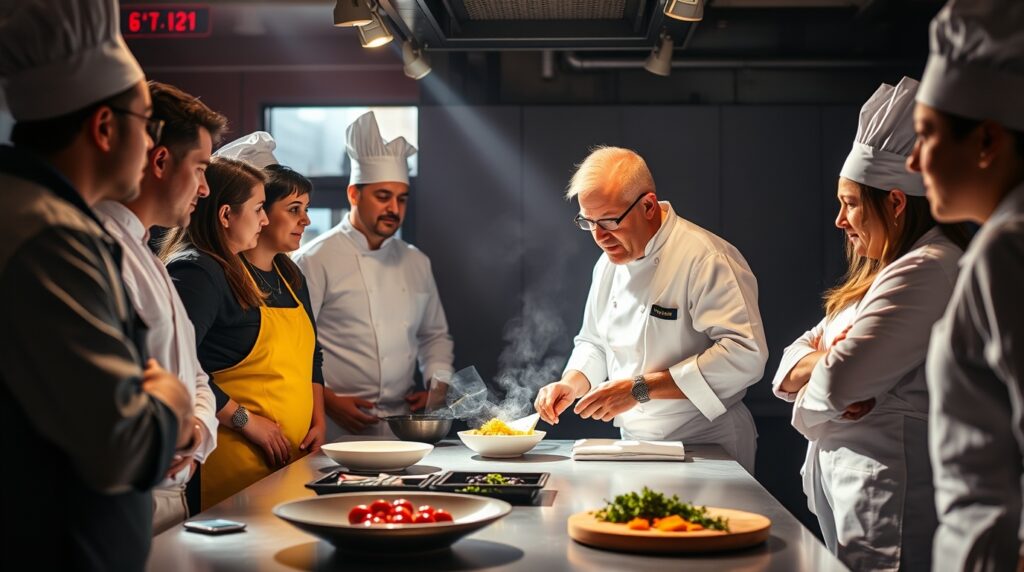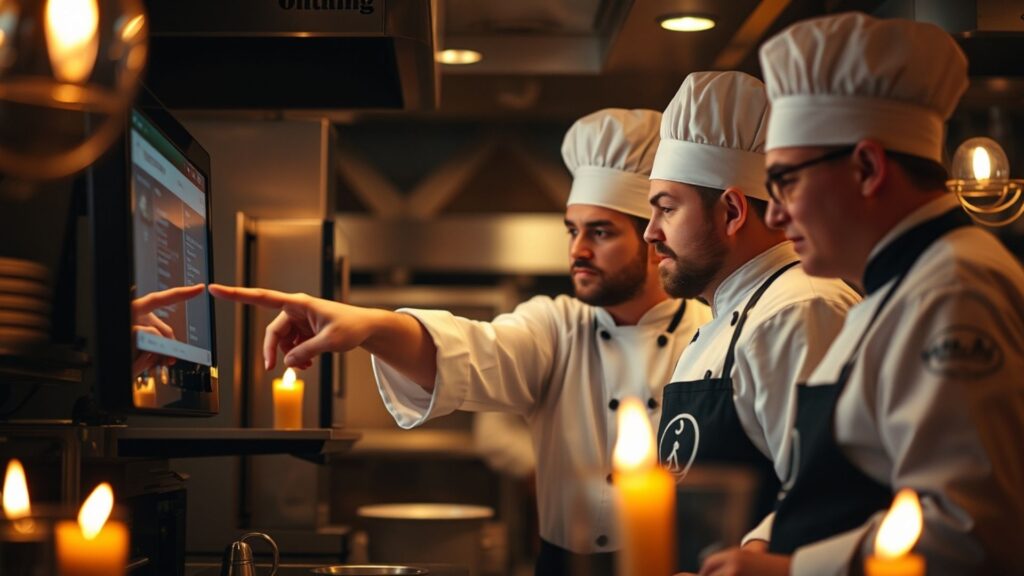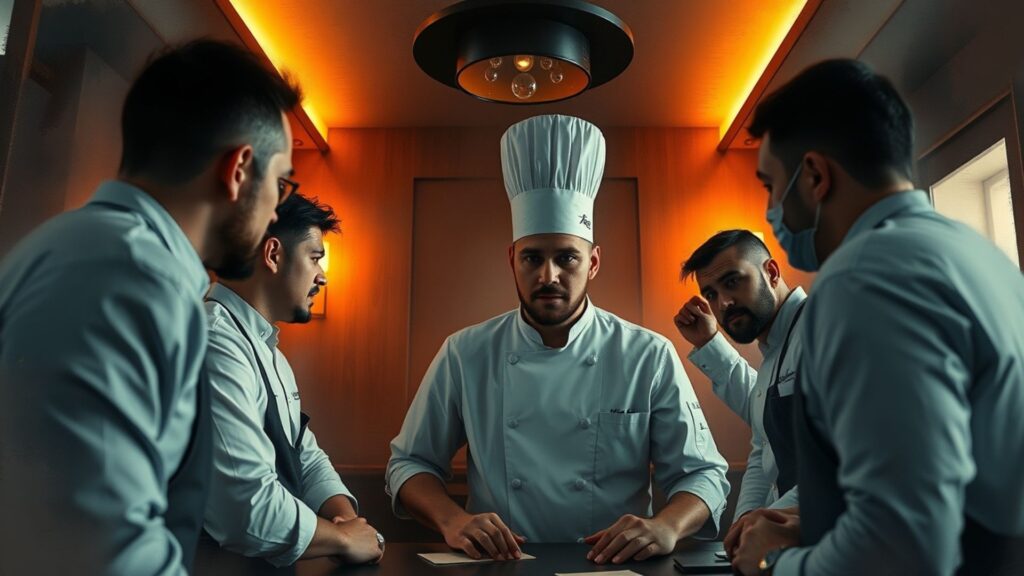
10 Key Strategies to Motivate and Develop Your Team in a Professional Kitchen
Introduction
In a professional kitchen, the pace is fast, the demands are high, and the pressure never lets up. Maintaining an efficient, motivated, and well-trained team is essential not only for delivering exceptional service but also for retaining top talent. A team that works with passion, commitment, and well-developed skills directly impacts the quality of the dishes and overall customer satisfaction.
But how can an executive chef achieve this? Hiring staff with technical skills is not enough; it’s crucial to cultivate an environment where learning, communication, and motivation are foundational pillars.
In this article, we’ll explore 10 key strategies to develop and motivate your team in a professional kitchen, ensuring their long-term growth and commitment.
Tabla de Contenido
Step 1: Selecting the Right Talent
Choosing the right staff for your kitchen is the first step to building an efficient team. Hiring isn’t just about evaluating culinary skills — it’s also about identifying attitudes, values, and compatibility with the restaurant’s culture.
How can you choose the best candidates for your team?
Before hiring, define the type of profile your kitchen needs:
- Line Cook: Must be fast, organized, and able to follow recipes precisely.
- Kitchen Assistant: Must be capable of multitasking and learning quickly.
- Pastry Chef: Needs attention to detail and specialized pastry skills.
- Station Chef (Chef de Partie): Should have leadership experience and be specialized in a specific station.
Table: Essential Qualities of a Good Kitchen Team Member
| Quality | Description |
|---|---|
| Discipline | Ability to follow instructions and stay organized. |
| Speed and Accuracy | Executes tasks quickly without sacrificing quality. |
| Teamwork | Works well with others for efficient service. |
| Stress Resistance | Remains calm and productive under pressure. |
| Willingness to Learn | Open to improving skills and learning new techniques. |
How to Interview and Evaluate a Candidate
To ensure a candidate is a good fit for your team, use a combination of structured interviews and hands-on tests.
Checklist: Key Interview Questions for Kitchen Staff
- What’s the biggest challenge you’ve faced in a kitchen, and how did you handle it?
- How do you manage working under pressure during a high-traffic shift?
- What cooking techniques do you excel at, and where do you see room for improvement?
- How do you ensure food safety standards are followed at your station?
- Why do you want to work at this particular restaurant?

Step 2: Ongoing Training and Development
One of the keys to maintaining a high-performing kitchen team is continuous training. Hiring talent isn’t enough — investing in your staff’s development is essential to ensure their performance aligns with your restaurant’s standards.
Why is continuous training important in the kitchen?
- Ensures food and service quality: A well-trained team maintains consistency in flavor, presentation, and prep times.
- Enhances kitchen safety: Food safety training helps prevent accidents and sanitation issues.
- Reduces staff turnover: Employees who see growth opportunities within the restaurant are more likely to stay long-term.
- Improves operational efficiency: A trained team works more systematically, optimizing time and resources.
Effective Training Methods
- Cross-Training
Cross-training allows staff to learn multiple stations within the kitchen. This not only increases team versatility but also improves communication and collaboration between departments.
✅ Benefits of cross-training:
- More flexibility with shift coverage
- Reduced impact when someone is absent
- Better understanding of the restaurant’s overall operations
🔹 Practical Example:
A line cook who usually works the grill could be trained on the garnish station. This helps during high-volume periods and deepens their understanding of kitchen synergy.
- Internal Mentoring
Pairing new employees with experienced cooks accelerates their learning curve and ensures they adopt the restaurant’s best practices.
✅ How to implement a mentoring program:
- Assign a mentor to each new hire
- Set clear learning objectives
- Encourage regular check-ins for questions and knowledge sharing
- Track progress and adjust training as needed
🔹 Practical Example:
An experienced chef can guide a kitchen assistant on how to optimize their station setup and improve service speed.
- Professional Certification
Certification programs like CAIBOK offer structured training that allows team members to build skills and advance their culinary careers.
✅ Advantages of certification:
- Greater recognition within the culinary industry
- Ensures compliance with quality and safety standards
- Increases team motivation by offering growth opportunities
🔹 Practical Example:
A line cook can earn a food safety certification, qualifying them for a promotion within the restaurant.

Get a Free Comprehensive Guide!
Learn how to build and lead a high-performing culinary team. Download it now and take advantage of this opportunity!
Step 3: Effective Communication and Leadership in the Kitchen
An efficient kitchen team relies not only on technical skills but also on clear communication and strong leadership. As an Executive Chef, you must establish strategies that ensure the team understands their responsibilities, stays motivated, and collaborates effectively.
Why is communication crucial in a kitchen?
- Prevents errors in orders and food preparation
- Reduces stress and conflicts within the team
- Improves efficiency and coordination between stations
- Fosters a culture of learning and professional growth
Strategies for Effective Communication in the Kitchen
1. Hold Daily Pre-Service Meetings
Short meetings before each service help organize the workflow, assign responsibilities, and prevent mistakes.
✅ What to cover in a pre-service meeting:
- Review the day’s menu and any updates
- Assign specific roles and stations
- Identify ingredients with limited availability
- Set goals for timing and service quality
🔹 Practical Example:
Before opening the restaurant, the chef informs the team that one of the proteins on the menu has changed and reviews how to adapt existing recipes accordingly.
2. Use Clear and Direct Language
In a professional kitchen, every second counts. Communication must be precise, fast, and unambiguous.
✅ Rules for effective communication:
- Use short, clear phrases
- Repeat key information to ensure understanding
- Avoid unnecessary jargon
- Implement codes or hand signals for high-pressure situations
🔹 Practical Example:
Instead of saying “Someone take care of the salmon,” give a direct order like: “Carlos, cook the salmon medium and plate it in 3 minutes.”
3. Foster a Culture of Constructive Feedback
Providing effective feedback helps employees improve without feeling criticized or discouraged.
✅ How to give constructive feedback:
- Be specific: Instead of “This dish isn’t right,” explain what needs improvement
- Mix critique with praise: “The flavor is great, but the presentation could be better”
- Focus on solutions: Offer concrete ways to fix mistakes
🔹 Practical Example:
If a chef notices a server taking too long to deliver a dish, instead of reprimanding, they explain how to optimize movements to speed up service.
Common Communication Mistakes in the Kitchen — and How to Fix Them
| Mistake | Solution |
|---|---|
| Ambiguous instructions | Give clear, direct orders |
| Lack of positive feedback | Don’t only criticize — acknowledge successes too |
| Poor station coordination | Use whiteboards or internal communication systems |
| Yelling or disrespect | Foster a professional, respectful learning environment |

¡Consigue una guía completa Gratis!
Descubre cómo construir y liderar un equipo culinario de excelencia. Descárgalo ahora. ¡Aprovecha esta oportunidad!
Step 4: Staff Motivation and Retention
The intense demands of a professional kitchen can lead to team burnout. To keep employees motivated and reduce turnover, it’s essential to offer incentives and growth opportunities. A successful Executive Chef focuses not only on the dishes leaving the kitchen but also on the well-being and satisfaction of the team.
Why is motivation important in the kitchen?
- Reduces staff turnover: A motivated team is more likely to stay long-term.
- Boosts performance and efficiency: A positive environment drives productivity.
- Strengthens company culture: Motivated employees reflect their enthusiasm through better service.
- Encourages creativity: Inspired teams are more likely to innovate in techniques and recipes.
Strategies to Keep the Team Motivated
1. Consistent Recognition and Positive Feedback
A simple “good job” can make a huge difference. Frequent recognition reinforces strong performance and boosts morale.
✅ How to apply recognition in the kitchen:
- Acknowledge individual and team efforts
- Highlight achievements in team meetings
- Use symbolic incentives like “Employee of the Month”
- Offer bonuses or time off for exceptional performance
🔹 Practical Example:
If a cook significantly improves speed and accuracy, the chef can publicly praise them during the daily meeting and reward them with a preferred shift.
2. Career Growth Within the Restaurant
When staff see clear growth opportunities, they become more motivated to improve.
✅ Ways to encourage professional growth:
- Promote from within before hiring externally
- Implement mentorship programs to train future leaders
- Offer certifications like CAIBOK to build stronger professional profiles
- Create career paths to help employees envision their future in the restaurant
🔹 Practical Example:
A dedicated kitchen assistant who develops their skills can be promoted to line cook after completing a training program.
3. Additional Benefits and Workplace Well-Being
Small perks can make a big difference in employee satisfaction and retention.
✅ Employee benefits that enhance retention:
- Flexible schedules when possible
- Free meals for staff
- Performance bonuses
- Team-building events outside of work
🔹 Practical Example:
A restaurant offers a special free meal each month to top-performing employees to foster motivation and camaraderie.
Table: Differences Between Poor Leadership and Motivational Leadership
| Factor | Poor Leadership | Motivational Leadership |
|---|---|---|
| Communication | Confusing, authoritarian orders | Clear instructions, positive tone |
| Feedback | Only negative criticism | Balanced feedback with recognition |
| Career Growth | No advancement opportunities | Promotions and continuous development |
| Work Environment | Constant stress and tension | Supportive and respectful culture |
Step 5: Onboarding and Integrating New Kitchen Staff
When a new employee joins the kitchen, quick and effective onboarding is key to maintaining smooth operations. A well-structured onboarding process not only helps the new team member feel welcome but also enhances their performance and reduces turnover.
Why is onboarding important?
- Shortens the learning curve: Staff learn kitchen procedures faster
- Reduces anxiety and stress: New hires feel safer and more confident
- Aligns new staff with restaurant values and standards
- Prevents operational mistakes that affect service quality
Strategies for Effective Onboarding
1. Structured Welcome Process
From day one, the new employee should feel part of the team and clearly understand their role.
✅ Key elements of a strong welcome:
- Introductions to the team and kitchen walkthrough
- Overview of restaurant culture and values
- Review of operations manual and safety protocols
- Assignment of a mentor or training partner
🔹 Practical Example:
The executive chef holds a short meeting with a new cook, explains expectations, introduces them to the team, and shows them their station.
2. Initial Training and Task Checklist
Provide a clear list of tasks and learning objectives for the first month to ensure knowledge acquisition.
✅ Example checklist for new cooks:
- Learn the location of ingredients and utensils
- Master hygiene and safety standards
- Understand the menu and how each dish is prepared
- Pass a basic prep test
- Receive feedback on performance
🔹 Practical Example:
During the first few weeks, a mentor monitors the new cook to ensure they can correctly prepare each menu item.
3. Ongoing Support and Evaluation
Onboarding doesn’t end after the first day — regular check-ins are crucial to ensure successful adaptation to the team and workflow.
✅ Ways to evaluate new hire integration:
- Feedback meetings after weeks one and three
- Performance reviews at 30 and 60 days
- Anonymous surveys for feedback on the onboarding process
🔹 Practical Example:
The executive chef schedules weekly check-ins with new hires to answer questions and adapt the onboarding process as needed.
Step 6: Creating a Positive Work Environment in the Kitchen
A positive kitchen work environment not only improves team morale but also directly impacts service quality and talent retention. The high-pressure nature of kitchens can create tension, making it essential to foster a culture of respect, collaboration, and mutual support.
Why is a positive work environment important?
- Reduces stress and mental fatigue, leading to better performance
- Encourages teamwork and communication
- Decreases turnover and retains top talent
- Boosts productivity and creativity in dish creation
Strategies to Foster a Positive Work Environment
1. Lead with Respect and Empathy
The attitude of the executive chef and leadership team sets the tone for the entire kitchen culture.
✅ How to be a positive kitchen leader:
- Actively listen to your team and value their input
- Provide constructive feedback without hostility
- Handle stress calmly; avoid yelling or insults
- Lead by example in professionalism and work ethic
🔹 Practical Example:
A chef notices a cook making mistakes due to stress. Instead of reacting harshly, the chef takes time to understand the situation and offers guidance.
2. Promote Teamwork and Collaboration
A well-coordinated kitchen depends on strong cooperation among team members.
✅ Actions to build teamwork:
- Organize team-building activities outside of work
- Rotate tasks to help staff understand each other’s roles
- Foster a culture of mutual support during high-pressure shifts
- Host internal competitions to encourage creativity and learning
🔹 Practical Example:
The kitchen team holds a monthly challenge where each cook presents a new dish and receives peer feedback.
3. Implement Wellness Practices in the Kitchen
Team members’ physical and mental well-being directly impact their daily performance.
✅ Ways to support staff wellness:
- Ensure proper breaks during shifts
- Maintain a clean, safe, and organized work environment
- Offer wellness programs or health incentives
- Provide ergonomic uniforms and equipment to reduce fatigue
🔹 Practical Example:
A restaurant adopts rotating shifts to prevent employees from working excessively long hours without rest.
Table: Differences Between a Toxic and Positive Work Culture
| Factor | Toxic Culture | Positive Culture |
|---|---|---|
| Communication | Yelling, confusion, lack of clarity | Open, clear communication at all levels |
| Teamwork | Destructive competition, frequent conflict | Mutual support and consistent collaboration |
| Employee Well-Being | Long shifts with no breaks | Scheduled breaks and fair shift rotation |
| Feedback | Only negative, no solutions | Balanced feedback with recognition for effort |

Step 7: Managing Stress in the Professional Kitchen
Stress in a professional kitchen is inevitable due to the fast-paced service, pressure for quality, and tight timelines. However, effective stress management can mean the difference between a burnt-out team and one that works with energy and efficiency.
Why Is Stress Management Crucial in the Kitchen?
- Reduces errors during food preparation
- Improves mental and physical health of employees
- Lowers turnover caused by burnout
- Promotes a more organized and controlled work environment
Strategies to Reduce Stress in the Kitchen
1. Efficient Organization and Planning
A well-organized kitchen allows teams to anticipate issues and avoid service-time crises.
✅ Organizational techniques to reduce stress:
- Implement an effective mise en place system
- Set prep-time deadlines before service begins
- Use whiteboards or screens to coordinate incoming orders
- Distribute tasks evenly to avoid overloading team members
🔹 Practical Example:
A restaurant trains its team to spend 30 minutes before each service preparing ingredients, checking tools, and coordinating kitchen stations.
2. Time Management and Role Assignment
When every team member knows exactly what to do and how long they have to do it, stress levels drop significantly.
✅ How to manage time in the kitchen:
- Assign tasks based on each employee’s strengths
- Use timers for cooking and dish delivery times
- Minimize unnecessary verbal orders with digital ticket systems
- Apply the “3-minute rule”: each dish should move to the next station within three minutes
🔹 Practical Example:
During peak hours, the head chef divides responsibilities strategically so no one is overloaded and all orders are delivered on time.
3. Create Strategic Breaks for the Team
Short breaks help the team recharge without disrupting service flow.
✅ How to structure breaks in the kitchen:
- Implement rotating 5–10 minute breaks every 3 hours
- Ensure staff has time to eat and stay hydrated
- Provide comfortable, well-ventilated break areas
- Encourage quick breathing or relaxation techniques
🔹 Practical Example:
In a high-demand kitchen, the executive chef schedules staggered breaks so everyone can pause without affecting operations.
4. Boost Morale Through Incentives and Team Dynamics
Stress levels drop when the team feels motivated and appreciated.
✅ Ways to boost team morale:
- Create friendly kitchen challenges to encourage learning
- Offer symbolic prizes for outstanding performance
- Celebrate team achievements with small internal events
- Listen to staff concerns and implement real solutions
🔹 Practical Example:
A restaurant hosts a monthly competition between kitchen stations. The winner receives a special recognition and a bonus, creating a fun and rewarding atmosphere.

¡Consigue una guía completa Gratis!
Descubre cómo construir y liderar un equipo culinario de excelencia. Descárgalo ahora. ¡Aprovecha esta oportunidad!
PStep 8: Creating an Incentive Program for the Team
One of the most effective ways to keep a kitchen team motivated and committed is by implementing a well-structured incentive program. These incentives can go beyond monetary rewards and include benefits that reinforce the restaurant’s culture and support employees’ professional growth.
Why Are Incentives Important in the Kitchen?
- Encourage employee engagement and loyalty
- Boost productivity and service efficiency
- Lower turnover by helping staff feel valued
- Promote continuous improvement and learning
Types of Incentives for Kitchen Staff
1. Financial Incentives and Bonuses
Financial rewards are one of the most direct and appreciated forms of motivation.
✅ Examples of financial incentives:
- Bonuses for outstanding performance during peak shifts
- Progressive salary increases based on experience and tenure
- Fair tip-sharing programs across the kitchen team
- Special pay for extra hours during events or catering jobs
🔹 Practical Example:
During high-demand seasons, a restaurant offers a 10% bonus to cooks if service times are consistently met.
2. Professional Development Incentives
Offering learning and growth opportunities is key to retaining top talent in the kitchen.
✅ Examples of professional growth incentives:
- Access to culinary certifications like CAIBOK
- Scholarships or partial funding for specialization courses
- Opportunities to attend workshops, food fairs, or cooking competitions
- Internal promotion programs based on performance
🔹 Practical Example:
A restaurant covers 50% of the cost of an international culinary certification for employees who have been with the team for over a year.
3. Quality of Life and Well-being Incentives
Work satisfaction also depends on a healthy work-life balance.
✅ Examples of well-being incentives:
- Extra days off for outstanding performance
- Flexible schedules for staff with specific needs
- Health insurance or medical benefits for the team
- Free or discounted meals for employees and their families
🔹 Practical Example:
A restaurant hosts a monthly special meal where employees can invite one guest free of charge.
4. Recognition and Cultural Incentives
Symbolic recognition is also a powerful motivator within a kitchen team.
✅ Examples of recognition-based incentives:
- “Chef of the Month” award with a plaque or special badge
- Social media shoutouts highlighting staff achievements
- Badges or pins awarded for specific milestones or goals
- Letters of recommendation for future promotions or personal projects
🔹 Practical Example:
Each month, the kitchen team votes for the coworker who best embodies the restaurant’s values. The winner receives a recognition badge and a special bonus.

Step 9: Implementing Technology to Improve Team Management
Technology has transformed the foodservice industry by streamlining organization, communication, and kitchen efficiency. Introducing digital tools into kitchen team management not only reduces operational stress but also enhances production timelines and improves coordination between workstations.
Why Is Technology Important in a Professional Kitchen?
- Automates repetitive tasks, freeing time for critical operations
- Improves communication among team members
- Optimizes inventory and order management
- Enables performance tracking and accountability
- Provides real-time data for better decision-making
Tech Tools to Manage a Kitchen Team
1. Restaurant Management Software
Management systems allow you to oversee all kitchen operations from a single dashboard.
✅ Key features of restaurant software:
- Shift scheduling and role assignments
- Real-time inventory control
- Order tracking to prevent mix-ups
- Monitoring prep and delivery times
🔹 Practical Example:
A restaurant implements a POS (Point of Sale) system that sends orders directly to the kitchen, reducing miscommunication and improving delivery speed.
2. Internal Communication Apps
Messaging apps help maintain clear, fast communication without relying solely on verbal commands.
✅ Useful tools:
- Slack: For coordinating tasks and sharing real-time updates
- Trello or Asana: For assigning daily responsibilities and tracking progress
- WhatsApp Business: To send alerts about shift changes or ingredient availability
🔹 Practical Example:
The kitchen team uses a Slack channel to post schedule changes and resolve daily operational questions in real time.
3. Kitchen Display Systems (KDS) and Digital Order Screens
Kitchen monitors eliminate paper tickets and help organize service timing more efficiently.
✅ Benefits of digital kitchen screens:
- Orders appear instantly with no intermediaries
- Reduces errors from misread handwritten tickets
- Orders can be marked as “in progress” or “ready to serve”
🔹 Practical Example:
A high-volume restaurant installs KDS screens so cooks can see all active orders and track the remaining prep time for each.
4. Inventory and Cost Management Systems
Proper inventory control helps minimize waste and lower operating costs.
✅ Recommended inventory software:
- MarketMan: Manages supplies, prices, and vendor orders
- Upserve: Analyzes consumption patterns and improves purchasing
- Toast POS: Automates purchasing and cost tracking
🔹 Practical Example:
A restaurant uses inventory software that alerts the chef when a key ingredient is running low, allowing timely reordering before service is affected.

Step 10: Measuring Team Performance and Conducting Evaluations
To ensure that motivation and development strategies in the kitchen are truly effective, it’s essential to implement metrics and performance evaluation systems. Tracking performance helps identify areas for improvement, reward team efforts, and optimize operational processes.
Why Is It Important to Evaluate Kitchen Team Performance?
- Identifies team strengths and weaknesses
- Supports merit-based promotions and advancement
- Improves productivity and service timing
- Reduces mistakes in dishes and orders
- Fosters a culture of continuous improvement
Key Metrics to Evaluate Kitchen Team Performance
1. Dish Production and Delivery Times
An efficient team should maintain optimal prep and service times.
✅ Service time performance indicators:
- Average preparation time per dish
- Customer wait times during peak hours
- Percentage of dishes served within the estimated timeframe
🔹 Practical Example:
If the expected prep time for a dish is 10 minutes but the team takes 15, bottlenecks can be identified and processes adjusted.
2. Accuracy and Quality of Dish Preparation
The team must ensure each dish meets standards for flavor, presentation, and temperature.
✅ How to measure kitchen accuracy:
- Number of dishes returned due to errors or poor cooking
- Quality checks conducted by the executive chef
- Customer satisfaction based on reviews and surveys
🔹 Practical Example:
A restaurant monitors Google Reviews and customer feedback to improve consistency in dish preparation.
3. Communication and Teamwork Levels
A well-coordinated team makes fewer errors and works more efficiently.
✅ Indicators of communication and collaboration:
- Number of misinterpreted or incomplete orders
- Internal employee satisfaction surveys
- Staff turnover rate (a high rate may indicate poor work culture)
🔹 Practical Example:
The executive chef holds monthly team meetings to review internal communication issues and implement improvements.

¡Consigue una guía completa Gratis!
Descubre cómo construir y liderar un equipo culinario de excelencia. Descárgalo ahora. ¡Aprovecha esta oportunidad!
4. Team Engagement and Motivation
It’s important to measure how motivated and engaged your kitchen staff is.
✅ Key indicators of motivation:
- Punctuality and consistent attendance
- Participation in training programs and certifications
- Interest in growing professionally within the restaurant
🔹 Practical Example:
A cook who actively seeks to learn new techniques and participates in internal training sessions demonstrates strong motivation and commitment.
How to Implement a Performance Evaluation System
- Define the goals of the evaluation: Are you measuring productivity, quality, teamwork, or motivation?
- Create a rating scale: Use a 1-to-5 system or customize a scoring method tailored to kitchen operations
- Conduct evaluations regularly: Every 3 to 6 months to track team progress
- Provide individualized feedback: Highlight each employee’s strengths and areas for improvement
- Adjust strategies based on results: Introduce training or operational changes if needed
🔹 Practical Example:
A high-end restaurant implements a biannual performance review system for its kitchen team. During the review, the executive chef and kitchen manager assess both individual and group performance using key metrics like service timing, preparation accuracy, and teamwork.
Each team member receives a rating from 1 to 5 across various performance areas. After the review, one-on-one meetings are held to provide personalized feedback, outlining strengths and areas to work on.
For example, if a line cook scores low on “service efficiency,” they are enrolled in a training focused on production speed. If a pastry chef earns a high score in creativity, they are given the responsibility to design a special dessert for the monthly menu.
Thanks to this structured approach, the restaurant improves overall performance and fosters a culture of professional growth.
Conclusion: The Key to an Efficient and Motivated Kitchen
Managing a kitchen team is a dynamic process that requires strong leadership, organization, and clearly defined motivation strategies. A well-trained, motivated, and consistently evaluated team not only enhances service quality but also strengthens restaurant culture and reduces staff turnover.

10 Claves Poderosas para Seleccionar Talento en Cocina
[…] Para evaluar de manera justa a cada candidato, es recomendable asignar un puntaje a cada aspecto evaluado. […]